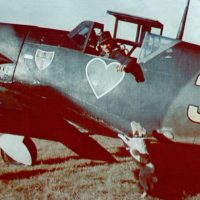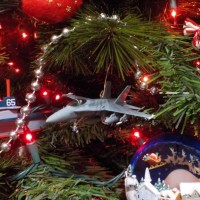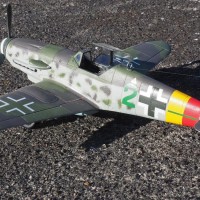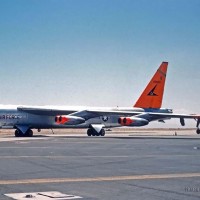Camouflage & Markings: Hawker Hurricane squadrons over France, 1939-1940
This article is part of a series:
I find the early versions of well-known fighters inspiring. With two-blade propellers, shifting configurations, flimsy canopies, unusual markings, camouflage experiments, what's not to like for a modeler? Add a few twists and turns of service introduction history, and you have a complete source of modeling inspiration.
Devised as a “Fury Monoplane,” the early Hawker Hurricane was rooted in the Golden Age of aviation. While it is widely celebrated for its role in the Battle of Britain, the Hurricane's combat exploits over France during 1939-1940 remain a somewhat overlooked but interesting chapter of its long operational history.
A few general notes
The initial production batch of Hurricanes, with serial numbers ranging between L1547..L2146, featured fabric-covered wings. In the second production batch, the first 80 aircraft with serial numbers N2318..N2729 also had fabric wings. The transition to metal wings began with the later aircraft in the second production batch. By the third production batch, starting with serial number P3265, all Hurricanes were equipped with metal wings at the factory.
The initial aircraft suffered from directional stability issues. This was remedied by Hawker by adding an elongated ventral fin somewhat early during the first production run.
All early production Hurricanes were fitted with Watts two-blade, fixed pitch propeller, replacement of which with the two-speed de Havilland ones did not occur until during the Battle of France. Even better Rotol constant-speed units were provided only in the weeks preceding the Battle of Britain.
100-octane fuel (imported from Sun Oil Company in the United States) was adopted for first-line Fighter Command aircraft starting from April-May 1940. Importantly, the improved fuel was only available for home defense fighters; Hurricanes flying in France were fueled with standard 87-octane gasoline.
Air Chief Marshall Hugh Dowding famously demanded armoured cockpits for his fighter pilots. Armoured windscreens were introduced starting in Autumn 1939, but the majority of them arrived relatively late, in the weeks preceding the Battle of Britain. The same goes for reflector gunsights. And about the same time, early antenna masts were replaced by aerodynamic ones together with an improved radio. In the same round of updates were also an addition of a rear view mirror, from February 1940.
Because of the breakneck speed of these modifications between May and July 1940 there's generally a considerable difference in looks between most of the Hurricanes used in France and those which fought in the Battle of Britain.
Another visible item that evolved in the early service life of the Hurricane was the air speed probe, which started as a Venturi tube at the port side of the fuselage, then progressed to two-prone and finally a single-prone pitot tube underneath the port wing.
The colour profiles in this article were researched and drawn by Mr. Rick Kent, a former librarian and curator at the RAF Museum in Hendon. Used here with kind permission of the author.
NA-Z
Originally based in Tangmere, No. 1 Squadron was among the first contingent deployed to France as part of the RAF Advanced Air Striking Force. It deployed for Le Havre already on 8 September 1939. In October it flew over enemy territory for the first time and soon claimed its first victory, a Dornier Do 17 on 31 October. After a particularly bad winter, further successes were made in March and April 1940, until the Battle of France erupted in May. Within a week the squadron was bombed out of its base at Berry-au-Bac, north-west of Paris. A series of retreats followed, ending with an evacuation from France on 18 June, with a return to Tangmere on 23 June.
The unit's CO Squadron Leader Patrick Halahan famously defied regulations and ordered the guns to be sighted to converge at 250 yards, instead of the regulation 400 yards, which greatly increased the Hurricane's combat effectiveness.
The top-scoring ace of the squadron during the period was F/O Les Clisby, an Australian with 19 confirmed victories, of which fourteen(!) were achieved in the space of only three days between 12-14 May 1940. Sadly, this incredible luck could not last long. Already on15 May 1940, Clisby was killed in action against more than thirty Bf 110s over Reims.
Depicted just before the war, NA-Z featured no serial number, small Type B roundels on the fuselage and no underside markings. The lower surface scheme remains a bit enigmatic, and is shown here with silver nose followed by black & white wings, these colors extending to the rear fuselage of the aircraft.
L1833 NO-J
No. 85 Squadron in Debden, Essex received their first Hurricanes in September 1938.
L1833 was involved in a landing accident on 14 August 1939. Sergeant G E Goodman pulled undercarriage lever instead of flaps lever after landing causing the undercarriage to collapse. A good example of the complexities of operating a modern monoplane fighter faced by the pilots of the day!
On the outbreak of the Second World War, No. 85 Squadron moved its 16 Hurricanes to Boos as part of the Air Component of the British Expeditionary Force. Initial sorties involved patrols over the English Channel and a move to Merville was instigated in late September. By 1 November 1939, another move saw the squadron posted to Lille Seclin, with sections detached to Le Touquet and Saint-Inglevert. During one patrol over the Boulogne area, the squadron scored its first victory of the war, when Flight Lieutenant R. H. A. Lee attacked a He 111 which crashed into the Channel.
When the German Blitzkrieg commenced on 10th May 1940, No. 85 Squadron found itself locked in a bitter contest with the Luftwaffe, and with attacks on its aerodromes being a commonplace, there was no respite from operations. In an eleven-day period the squadron accounted for a confirmed total of 90 enemy aircraft, then returned to the UK, severely depleted - two pilots killed, six wounded and nine missing.
L1833 which saw action over France was then assigned to 6 OTU (Operational Training Unit). It didn't last long with 6 OTU as it was destroyed on 3rd September 1940 in a mid-air collision with another Hurricane near Bank Farm, Norfolk. During an authorised combat flying experience, the OTU instructor and the trainee pilot momentarily lost sight of each other due to a bright morning sunlight and collided, instantly killing both pilots.
KW-U L1945
No. 615 Squadron were late newcomers to the Hurricane. The squadron went to France in November 1939, equipped with Gloster Gladiators, as part of the Air Component of the British Expeditionary Force.
Pilot conversion to the Hawker Hurricane took place in the early months of 1940, with the aircraft themselves finally arriving in May 1940 as the German invasion of France was already underway.
The next couple of weeks were marked by chaos and constant shuffling between bases that included Vitry-en-Artois, Saint-Inglevert, Poix, Abbeville and Moorsele in Belgium. On 20 May 1940, whilst some ground crew & equipment were already making their way towards evacuation via Boulogne, patrols were still being carried out, with a Heinkel He 111 shot down by P/O Petrus Hugo. Finally, the last nine serviceable Hurricanes flew home to RAF Kenley, whilst non-flying crew returned to England on a ship from Boulogne.
L1945 is an example of the aircraft delivered to France in May 1940. It has non-standard Type A1 roundels on the fuselage, Type A in lower wing positions and Type B upper roundels, plus the newly-introduced type of fin flash at the fixed portion of the tail. Black-and-white undersides. Produced in Hawker Brooklands in May 1939, it has fabric wing, ring-and-bead gunsight and early antenna mast, but also a ventral fin, ejector exhausts, three-blade de Havilland propeller and a pitot tube under its port wing.
TM-B
Northolt was the first RAF station to operate the Hawker Hurricane, with No. 111 Squadron receiving the first four aircraft in December 1937, and reaching its full complement by February 1938.
The squadron carried code letters 'TM' between April and September 1939, later replaced by 'JU'. This is not to be confused with No. 504 Squadron, which "inherited" the code 'TM' from September 1939.
No. 111 Squadron had a brief and somewhat half-hearted spell in the Battle of France. On 16 May 1940, a flight from No. 111 Squadron joined a flight from No. 253 Squadron to form a joint unit, with one half deploying to France and the other remaining in Britain. It was a makeshift measure intended on one hand to to meet a personal request by Winston Churchill to send more fighter squadrons to France in support of the collapsing campaign, on the other hand aimed at preserving some defensive capacity at home.
It was the very same day of 16 May that Air Chief Marshal Hugh Dowding wrote the famous letter to the Air Ministry requesting that a sufficient Home Defence fighter force be maintained in Britain and that until the minimum strength was reached "not a single further fighter should be sent to France."
Shown here is a Hurricane Mk. I from No. 111. The serial numbers were omitted. Typical configuration for the period includes fabric wings, two-blade propeller, ring-and-bead gunsight, unarmoured windscreen, ejector exhausts, ventral fin and early type of antenna installation. Paint-wise, small Type B roudels at the fuselage, black-and-white undersides with no markings, which may indicate Brooklands production.
L1718 AL-T
No. 79 Squadron received their Hawker Hurricane fighters in November 1938. They scored their first success on 21 November 1939, with a Dornier Do 17 claimed over the English Channel.
No.79 was deployed to Mons-en-Chaussee on 10 May 1940 at the start of the German offensive in the West.
Once on the continent, they moved on to Norrent Fontes, then Merville, avoiding the German advance. After only ten days, the imminent fall of France forced the squadron to return to Britain.
During the French campaign the squadron claimed 25 German aircraft.
L1718 was the aircraft from the first production block, with fabric wing, two-blade propeller, original-style antenna mast, ring-and-bead gunsight, unarmoured windscreen. The ejector exhausts were already in place, as was the ventral fin. Small Type B roundels on the fuselage, and no markings underneath except for black-and-white undersides. Not much is known about its fate; some sources state it was lost over France on 18th May 1940, pilot unknown.
KT-W
No. 32 Squadron received the Hawker Hurricane in October 1938, replacing their Gloster Gauntlets.
L1662 depicted here, carrying pre-war squadron codes KT (later changed to GZ), was one of the Hurricanes that didn't last to see the war. On 11th August 1939, No. 32 Squadron was taking part in the Annual Home Defence Air Exercise, being employed as a night flying squadron. During the night of 10-11 August, Flying Officer Arthur Robin Buchanan Wollaston and Pilot Officer Harold Stewart Olding each crashed in a fog into hills near Tatsfield in two separate incidents. The pilots were killed. One of the Hurricanes was L1567, another L1662.
During the Battle of France, No. 32 Squadron flew patrols over northern France, and took part in the defence of south-east England operating from Biggin Hill. They also flew missions over France using Abbeville as a forward base.
L1975 UV-K
No. 17 Squadron flew defensive patrols from numerous bases in Britain, including Debden and Martlesham Heath. After the German onslaught on the low countries and France in May 1940, fighter sweeps were extended to cover the Netherlands, Belgium and French airfields to cover the retreat of BEF troops. In June 1940, the Squadron moved to Brittany as the remnants of BEF and RAF units in France were evacuated, retiring to the Channel Islands for two days before returning to the UK.
L1975 is depicted here as it appeared in February 1939, with silver undersides, black serials under the wings, Type A roundels. A squadron badge, featuring a silver Gauntlet (a homage to the Gloster Gauntlets previously flown by the unit) is painted on both sides of the fin.
This Hurricane was lost On August 15, 1940, a fateful day in the Battle of Britain. Pilot Officer J.L.W. Ellacombe was wounded in combat and performed a rough belly landing in L1975, damaging the aircraft, which was subsequently struck off-charge. Despite his injuries, Ellacombe quickly returned to flying. However, his challenges were far from over. On August 30, he was forced to land another damaged Hurricane near Hundsdon, just before the Heinkel He 111 he had shot down crashed in an adjacent field. The following day, Ellacombe's aircraft was hit by return fire from a Ju 88, causing the fuel tank to explode. He bailed out and was admitted to Southend General Hospital with burns.
To be continued...











Another superb reference article, Martin!
Thanks for sharing, waiting for the follow-up!
Appreciate the feedback @fiveten!
Very cool, Martin (@editor). Lots of interesting info and color profiles. Thanks for posting.
Thank you, George @gblair!
Thank you for this, Martin @editor. I absolutely love RAF early WW2 schemes. Airfix have some nice Hurricanes in 72nd scale with schemes from the campaign in France in 1940.
Yes I love them, too @fxrob. I think it's a pity that we don't have a mainstream 1/48 kit of a rag-wing Hurricane. In 1/72, Airfix has luckily provided a solution.
Great reference material, Martin @editor
Thanks for sharing.
Thank you @johnb!